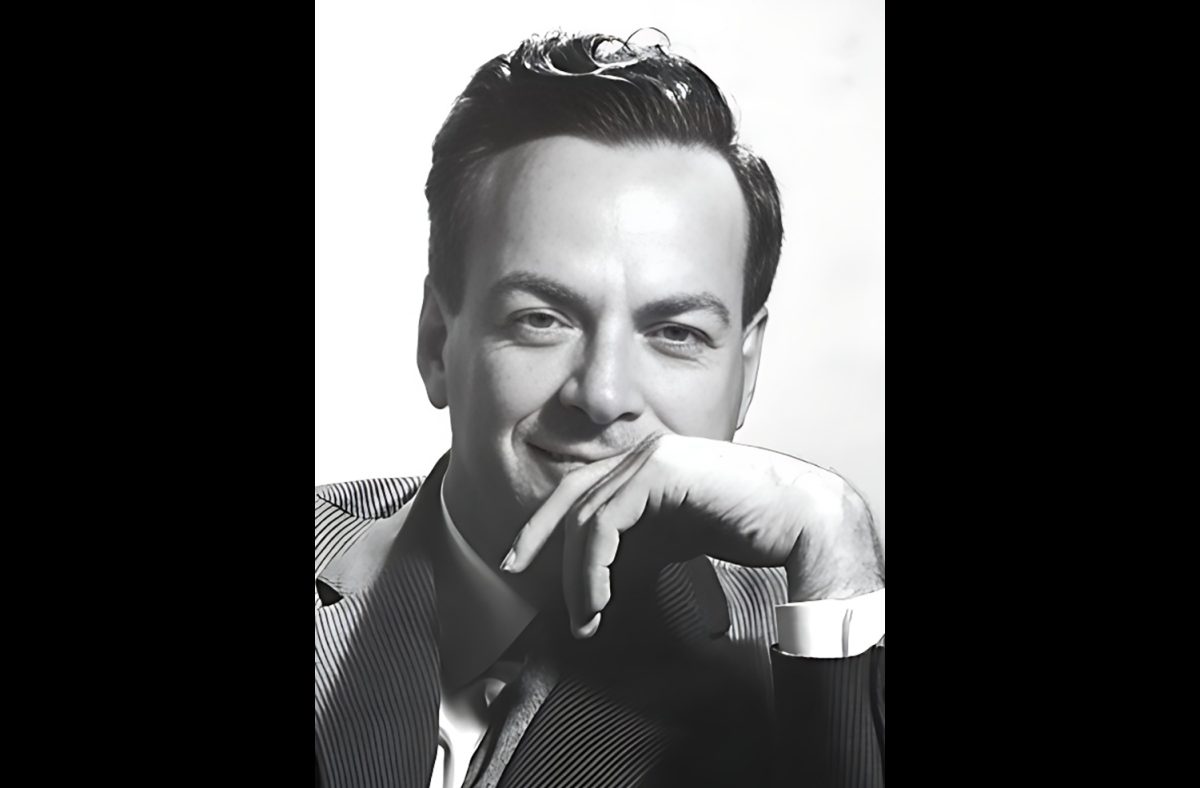Modern physics is often defined by the discovery of a pair of sweeping, powerful icons of nature, namely, the theories of general relativity and quantum mechanics, which were brought into the world at about the years 1915 and 1925, respectively.
But tucked between these two dates is the year 1918, and in the spring of that year there came into the world another sweeping icon capable of single-handedly revolutionizing modern physics, and that icon is Richard P. Feynman.
An architect of quantum theories, a brash young group leader on the atomic bomb project, and the inventor of the indispensable “Feynman Diagrams” for modeling particle behavior, Feynman took half-made conceptions of matter and energy in the 1940s and shaped them into simple tools that ordinary physicists could understand and calculate with to whopping precision.
Although his handiwork permeates the foundations of modern science, millions of Americans heard his name for the first time in 1986, when he brought an inquisitive and caustic presence to the Presidential Commission investigating the disastrous explosion of the Space Shuttle Challenger.
Early on, Feynman stunned a Washington hearing room by calling for ice water, plunking in a piece of the critical rubber O-ring seal (required to prevent hot exhaust gases from escaping the joints of the space shuttle’s solid rocket boosters) and then pinching it with a small clamp. Reasoning that the temperature of the ice water was close to 32 degrees – a close match for the air temperature when Challenger launched – the experiment could reasonably simulate the conditions of the explosion.
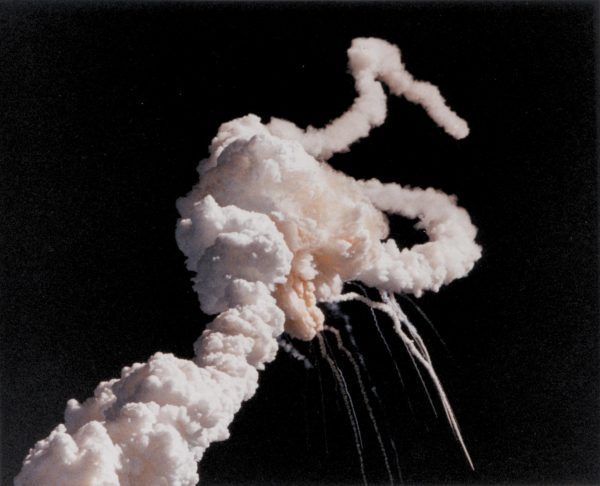
When the hearing resumed, Feynman pressed the red button on his mic. Now he was live on national TV. He held up a chunk of O-ring for the TV cameras, explaining, “I took this stuff that I got out of your seal, and I put it in ice water. And I discovered that when you put some pressure on it for awhile and then undo it, it doesn’t stretch back. It stays the same dimension. In other words, for a few seconds at least and more seconds than that, there is no resilience in this particular material when it is at a temperature of 32 degrees.”
Feynman’s demonstration was a turning point in the investigation – a simple experiment, taking half a minute and no money, that perfectly demonstrated both the vulnerability of the seal and the absolute confidence of the experimenter. Later, in his statement to NASA, Feynman delivered a harsh and independent verdict, “For a successful technology, reality must take precedence over public relations, for nature cannot be fooled.”
To physicists who knew Feynman as a colleague or as a teacher, neither his faith in nature’s simplicity nor his impatience with mediocrity came as a surprise. “He was the most original mind of his generation,” said Freeman Dyson of the Institute for Advanced Study in Princeton, N.J.
“He’s the most creative theoretical physicist of his time and a true genius,” said Sidney D. Drell, former president of the American Physical Society. “He has touched with his unique creativity just about every field of physics.”
Hans Bethe of Cornell University, paraphrasing the mathematician Mark Kac, said there were two kinds of geniuses. The ordinary kind does great things but lets other scientists feel that they could do the same if only they worked hard enough. The other kind performs magic. “A magician does things that nobody else could ever do and that seem completely unexpected,” Dr. Bethe said, “and that’s Feynman.”
Feynman reluctantly shared the 1965 Nobel Prize in Physics for work he completed in his 20s, recreating the theory of quantum electrodynamics, which governs every physical and chemical process except those embracing gravitation and radioactivity.
But Feynman couldn’t care about his recognition. When speaking about his feelings towards the prize, Feynman said, “I don’t like honors… I’ve already got the prize. The prize is the pleasure of finding the thing out, the kick in the discovery, the observation that other people use it. Those are the real things.”
He could have won it again, many believed, for work with American physicist Murray Gell-Mann that created a theory for weak interactions, describing such phenomena as the emission of electrons from radioactive nuclei.
Feynman himself is said to have liked the theory of weak interactions better. Feynman said, “I won the prize for shoving a great problem under the carpet, but in this case there was a moment when I knew how nature worked – it had elegance and beauty.”
He also formulated a mathematical theory that explained the strange behavior of liquid helium at temperatures a breath away from absolute zero, which at very low temperatures becomes superfluid, behaving as if it had no viscosity at all. And later, exploring the scattering of electrons in high-energy collisions at the Stanford Linear Accelerator Center, Feynman invented an illuminating theory for interpreting the cascades of radiation produced from quantum chromodynamics processes.
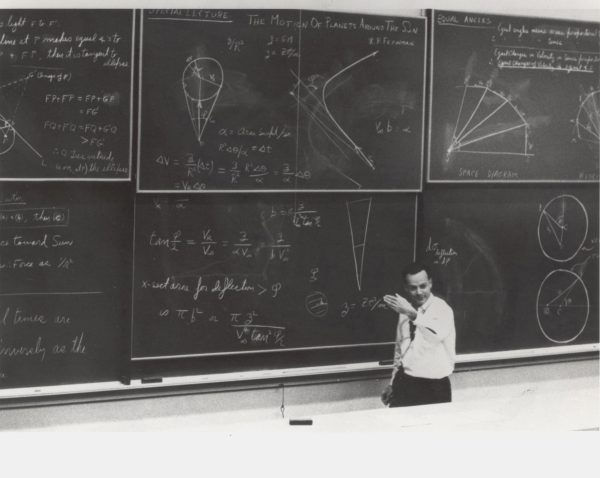
These were his four greatest scientific achievements, but he also left a deep mark on modern physics as an educator and an author. At Cornell University in the 1940s and then in a long career at the California Institute of Technology, Feynman developed a unique lecture style that kept him at the center of attention, the impossible combination of theoretical physicist and circus barker, full of body motion and sound effects.
One famous series of lectures was collected and published in three volumes that provide a deep, fundamental, and intuitive way to understand physics, The Feynman Lectures on Physics. His 1985 memoirs, Surely You’re Joking, Mr. Feynman!, became a surprising best-seller, prompting the publication of more memoirs in What Do You Care What Other People Think? The books are hilarious, with one story seeing him flubbing a sprinkler experiment in the cyclotron laboratory at Princeton University, shattering glass tubes and flooding the space with water.
Feynman loved telling stories about himself and observing the reaction — the more stunned, amused or horrified the better. Feynman’s popular books shattered the public’s preconceptions of scientists as lab-coated nerds and replaced them with a hipper image of a wild nonconformist.
Above all, in and out of science, Feynman was a curious character. He was never content with what he knew or what other people knew. He taught himself how to fix radios, pick locks, draw nudes, speak Portuguese, play the bongos, decipher Mayan hieroglyphics. He pursued knowledge without prejudice, studying the tracking ability of ants in his bathtub and learning enough biology to study the mutation of bacteriophages.
In his youth he experimented for months with trying to observe his stream of consciousness at the point of falling asleep; in his 50s he experimented with inducing out-of-body hallucinations in a sensory-deprivation tank. But Feynman was no mystic, and he despised all kinds of fake learning, particularly pseudoscience. He placed a good part of modern psychology in that category, calling it “cargo cult science.”
Certain Pacific Islanders, he explained, wanted the cargo planes to keep returning after World War II was over. So they made runways, stationed a man with wooden headphones and bamboo for antennas, lit some fires and waited for the planes to land. It is the same, he said, with cargo cult scientists. As Feynman put it in his 1974 commencement address at the California Institute of Technology, “They follow all the apparent precepts and forms of scientific investigation, but they’re missing something essential because the planes don’t land.”
As Feynman believed, our common misunderstanding of science runs deep. It finds its roots in the shortcomings of STEM education in schools and universities. What often goes unnoticed, Feynman says, is “a kind of scientific integrity, a principle of scientific thought that corresponds to a kind of utter honesty — a kind of leaning over backwards.” It isn’t enough to present a plausible experiment with plausible hypotheses and test it for plausible conclusions, science must doubly play its own devil’s advocate: present what might go wrong, what other causes could explain the results, what is assumed to be true or false, and what conclusions are dubious at best.
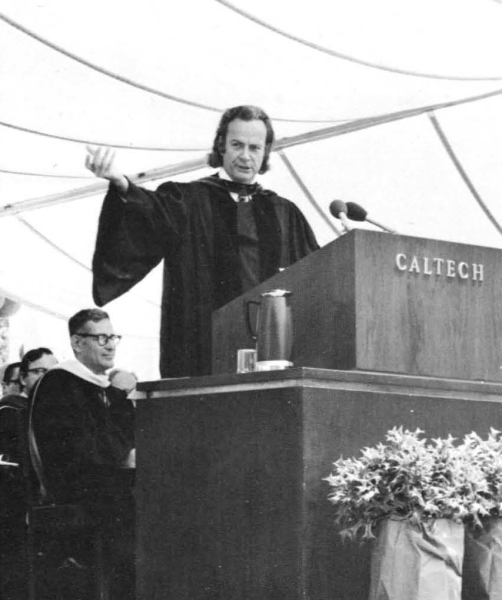
We might recognize cargo cult science in the outlandish beliefs everywhere around us: UFO’s, astrology, flat-Earth, the 2012 phenomenon, forms of mysticism, the Bermuda Triangle, expanded consciousness, and extrasensory perception. While such beliefs may appear obviously distinct from the sciences with their dense jargon and arcane symbols, in practice the distinction is often muddy. We are nudged by a slew of illusory cognitive biases in our day-to-day lives, but science intends to go beyond that. To do that, Feynman says, “you must not fool yourself — and you are the easiest person to fool… After you’ve not fooled yourself, it’s easy not to fool other scientists. You just have to be honest in a conventional way after that.”
Richard Phillips Feynman was born on May 11th, 1918, in Far Rockaway, Queens. The young Feynman was heavily influenced by his father Melville, who encouraged him to ask questions to challenge orthodox thinking, and who was always ready to teach Richard something novel. From his mother Lucille, Richard gained the sense of humor he maintained throughout his life.
Nine years after him, Richard’s sister Joan Feynman was born. Richard was eager to enthuse his long-awaited sibling with his excitement about the potential of science. As soon as she could speak, he started to train her in math. One of Joan’s earliest memories, at the age of two, is of tugging on Richard’s hair as he pulled funny faces to reward her for solving the simple number problems he’d set.
When Richard was in elementary school, he created a home burglar alarm system while his parents were out for the day running errands. His analytical approach to radio repair, a hobby he took up when he was 11 or 12 years old, gave him a neighborhood reputation as the boy wonder who could fix radios by thinking.
At his side, Joan helped Richard in his homespun electronics lab. “He hired me as his lab assistant at four cents a week,” she later remembers. “For that four cents I was expected to put my finger in a spark gap for the amusement of his friends!”
One day something didn’t seem right to Lucille, and she asked Joan to go and check on what Richard was doing. She found him in his room with a wastepaper basket, which he was holding with clippers outside the window, with a huge fire in it. “Is everything OK?” asked Joan. “Yep,” replied Richard. Joan returned to Lucille in the living room and reported that it was “just Richard with a fire. But it’s OK. It’s outside the window!”
“That was our family,” Joan reminisced later in life. “A great family to grow up in.”
One night, Richard woke Joan up and told her to follow him out into the street. He took her away from the house and the street lights and out onto a wide open golf course nearby with a big dark sky above them. “I can still remember in my mind’s eye the green lights dancing in the sky,” Joan recalls of the flickering northern lights Richard had led her outside to witness. “He told me that it was an aurora and no one knew what caused it exactly.” Such a magical childhood experience would inspire Joan’s future as an astrophysicist specializing in aurora borealis phenomenon.
After graduating from Far Rockaway High School in 1935, Richard went on to the Massachusetts Institute of Technology and then to Princeton University on a scholarship.
One of the conditions of the scholarship was that Feynman could not be married; nevertheless, he continued to meet his high school sweetheart, Arline Greenbaum, and was determined to marry her once he had been awarded his PhD, despite the knowledge that she was seriously ill with tuberculosis. It was an incurable disease at the time, and she was not expected to live more than two years. On June 29th, 1942, they took the ferry to Staten Island, where they were married in the city office. Feynman could kiss Arline only on the cheek.
By then, Feynman had been recruited for the Manhattan Project to build an atomic bomb at Los Alamos Laboratory, N.M.
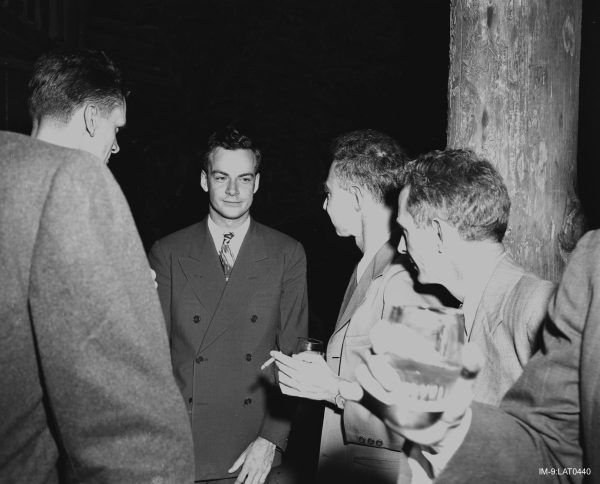
Stories from the time, including Feynman’s own, give the impression that he spent most of his time thinking up ways to infuriate the military censors and security officers. In many ways, that is true. Like other young physicists, Feynman fell under the spell of the charismatic Oppenheimer, who telephoned Feynman to inform him that he found a Presbyterian sanatorium in Albuquerque, New Mexico for Arline. To avoid inspection from officers, Feynman and his first wife exchanged letters they had cut into pieces of a jigsaw puzzle.
While at Los Alamos, Feynman entertained himself by cracking the combination locks that had been installed to protect the bomb secrets – the plutonium production schedules, the construction dimensions, the neutron radiation data, “the whole schmear,” as he later wrote. When the responsible officers turned their backs he would unlock the steel doors and leave notes with amusing messages such as, “I borrowed document No. LA4312 – Feynman the safecracker.”
But Feynman’s real role was deeper than he liked to suggest in his memoirs. Dr. Bethe, the leader of the theoretical division, recognized him as the most ingenious member of his team. The two men devised a formula for predicting the energy yield of a nuclear weapon. Feynman also took charge of the project’s computing effort, using rows of new machines to try to manage the vast amount of numerical calculations required.
On weekends, Feynman would borrow a car from his friend, Klaus Fuchs, to drive to Albuquerque to see Arline. Feynman’s $380 (equivalent to $7,000 in 2023) monthly salary was about half the amount needed for his modest living expenses and Arline’s medical bills, and they were forced to dip into her $3,300 (equivalent to $58,000 in 2023) in savings.
Informed that Arline was dying, Feynman drove to Albuquerque and sat with her for hours until she died on June 16, 1945. She was 25 years old. 16 months later, Feynman wrote his late wife a heartbreaking love letter and sealed it in an envelope. It remained unopened until after his death in 1988. “I love my wife. My wife is dead,” Feynman wrote.
In his grief, Feynman buried himself in work on the project and was present during the Trinity nuclear test. He said he was possibly the only man confident enough or reckless enough to watch the first atomic bomb with the naked eye, protected only by a truck windshield. Feynman decided that the only harm could come from ultraviolet rays and that the window glass would screen those.
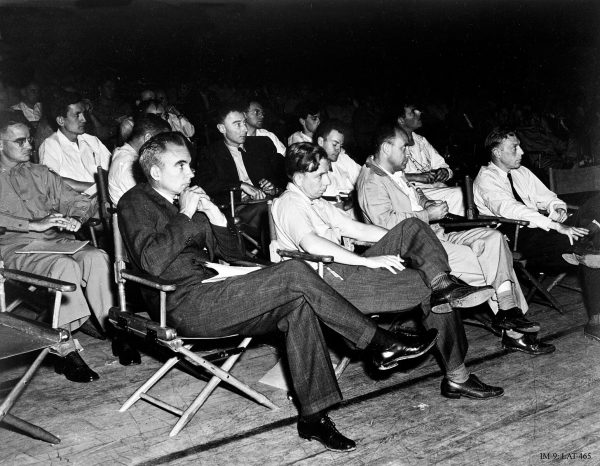
Feynman’s years with the Manhattan Project brought the brazen young scientist into close contact with the world’s greatest physicists and mathematicians. He would attend meetings in Edward Teller’s office, furiously exchanging ideas with Enrico Fermi and John von Neumann, manipulating his desk calculator at top speed while von Neumann worked the same problems in his head.
Only afterward, sitting in a New York restaurant and calculating the radius of potential bomb damage on midtown Manhattan, did Feynman lose the euphoric feeling that drove him in the years he worked to develop the bomb. “You see, what happened to me – what happened to the rest of us,” he wrote, “is we started for a good reason, then you’re working very hard to accomplish something, and it’s pleasure, it’s excitement. And you stop thinking, you know; you just stop.”
When World War II ended, Feynman accepted an invitation from Dr. Bethe to teach at Cornell in October 1944. But his father died suddenly on October 8, 1946, and Feynman had become depressed and restless from the numerous tragedies that befell his life.
Unable to focus on research problems, Feynman began tackling physics problems, not for utility, but for self-satisfaction. His work during this period ultimately proved important to his Nobel Prize-winning work, yet because he felt burned out and had turned his attention to less immediately practical problems, he was surprised by the offers of professorships from other renowned universities.
Elsewhere, Joan Feynman had become an accomplished astrophysicist with pioneering work on the mechanism responsible for auroras. She found this work wonderful, and her instinct was to tell her brother, who’d first introduced her to the beautiful phenomena in her childhood. But then a second thought crossed her mind.
“Richard is pretty smart, and if I tell him about an interesting problem, he’ll find the answer before I do and take all the fun out of it for me.” So Joan decided to strike a deal with him. “I said, ‘Look, I don’t want us to compete, so let’s divide up physics between us. I’ll take auroras and you take the rest of the Universe.’ And he said OK!”
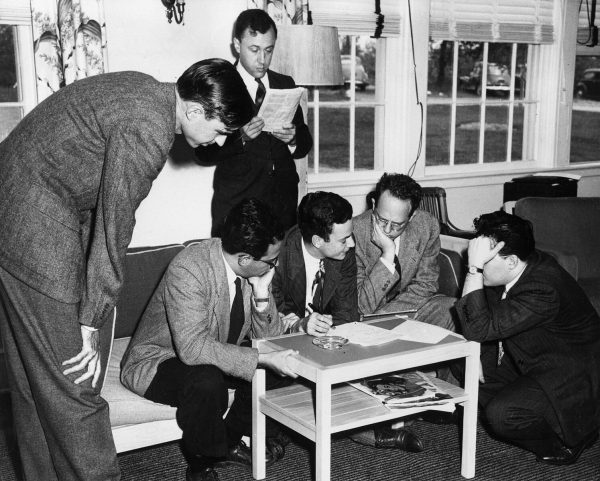
In a way, Feynman was born too late to uncover the big mysteries of the universe. By the 1940s, the two great revolutions of twentieth-century physics were in full swing. Einstein’s theory of general relativity had transformed scientists’ understanding of space and time, and quantum theory had transformed their understanding of the behavior of matter and energy in the guise of probabilistic particle-waves.
Together, these revolutions had made the atomic bomb possible. Now, physicists were applying them to a new framework within which to study the properties of fundamental particles and the relationship between gravity, electromagnetism and the forces that bind the atom together. A crucial part of this framework was quantum electrodynamics, a modernization of the classical understanding of electromagnetic radiation – radiation like light and radio waves – formulated in the 1800s.
In the domain of everyday life, electromagnetic forces are familiar and well-understood. At the subatomic level, however, where they govern the interaction of electrically-charged particles, the theory had run into trouble. Its predictions failed to match with experiments, and as physicists tried to make calculations more accurately, the discrepancies exploded to infinity.
Physicists struggled for more than a decade to find revisions that would make the theory work. Then, working independently, Feynman, Shin’ichirō Tomonaga of Japan and Julian Schwinger of Harvard University solved the problem. Dr. Tomonaga and Dr. Schwinger connected their work to the old theory in ways that other physicists could quickly understand. But Feynman rebuilt quantum electrodynamics from the ground up. He invented a new way of calculating using unusual squiggles, loops and lines that drew much skepticism at first.
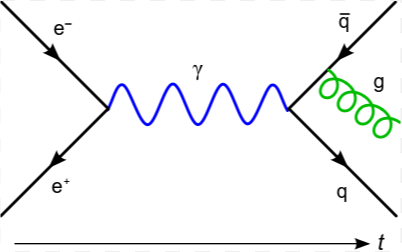
“He tried to rediscover the whole of physics by himself,” said Dr. Dyson, a close colleague of Feynman’s at Cornell. “Somewhat to his disappointment, what he discovered was in agreement with what other people had done. But he had to do it his own way, and what came out of it all was a new way of looking at things which has been enormously fruitful.”
Feynman’s approach, now in universal use by physicists, allowed calculation in areas that had been regarded as impossibly esoteric. He framed the events of physics in terms of particle interactions, abandoning the idea of waves, and he created a practical way of diagramming the interactions of particles that now bears his name – Feynman diagrams.
Feynman diagrams use lines to represent the histories of particles and nodes to represent their interactions. Using symbols in a highly abstract way, it became possible to understand complicated events that otherwise would have taken weeks to calculate. The resulting predictions have been verified to astonishing precision in a wide range of experiments. But the technique shocked some physicists trained in the old ways. Sometimes, a Feynman diagram would produce a result that ran contrary to all intuition – for example, an antiquark running backwards in time.
Another central notion was equally hard to swallow: that a physicist should make calculations not by solving some overall equation, but rather by taking all the possible histories of a particle interaction and adding them together, making a sum of probabilities. As Feynman himself said, the theory often seemed absurd.
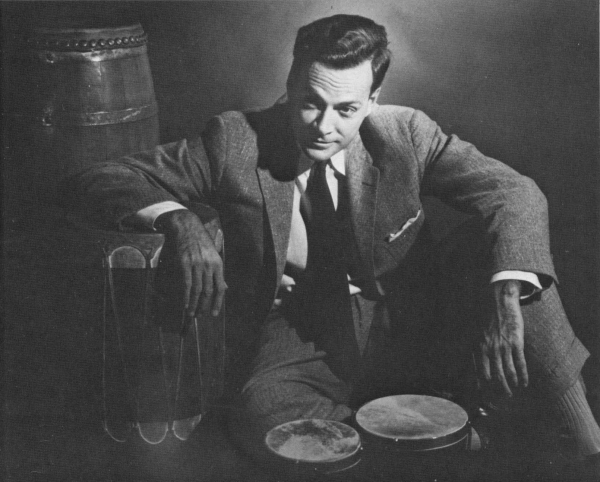
After four years at Cornell, Feynman felt ill at ease with the university. He never settled into a particular house or apartment, living in guest houses or student residences, or with married friends until the arrangements became unstable. He was not fond of Ithaca’s cold winter weather, and pined for a warmer climate. In 1950, Feynman accepted an offer and moved to the California Institute of Technology in Pasadena, where he spent the rest of his life following a short sabbatical in Brazil.
While at Brazil, Feynman was impressed with samba music, and learned to play the frigideira, a metal percussion instrument based on a frying pan. From then on, he was an enthusiastic player of the bongo and conga drums and often played them in the pit orchestra in student musicals that made him wildly popular.
At Caltech, Feynman taught a first-year course called ‘Physics X,’ in which students would ask him anything and he’d think on his feet. Feynman loved to astound, and often refused to provide solutions, to spur his student’s intellects. The students of Caltech quickly came to adore Feynman, hanging on his every word and creating a celebrity of the scientist.
After the success of quantum electrodynamics, Feynman turned to the budding field of quantum gravity, which searched for the peculiar properties of gravity at the finest scales. The computational device that Feynman discovered for gravity proved invaluable in explaining quantum particle behavior in the tiny gluons binding quarks together inside the atom.
Feynman had therefore done work on all four of the fundamental interactions of nature: electromagnetism, the weak & strong forces, and gravity. Science writers John and Mary Gribbin state in their book on Feynman that “Nobody else has made such influential contributions to the investigation of all four of the interactions.”
Feynman liked to speak of “the laws,” meaning the laws of nature, in a particularly clean sense. “If the only laws that you find are those which you have just finished observing, then you can never make any predictions,” he said.
“Of course, this means that science is uncertain – the moment that you make a proposition about a region of experience that you have not directly seen, then you must be uncertain,” Feynman continued. “But we always must make statements about the regions that we have not seen, or the whole business is no use.”
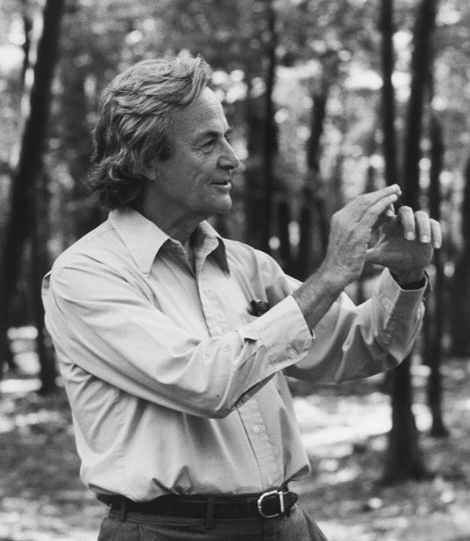
Feynman often conceptualized problems in a particularly mathematical way, always trying to cull the essence, the laws, from the physical details. Mathematics was nature’s very own language, he felt. “If you want to learn about nature, to appreciate nature, it is necessary to understand the language that she speaks in,” he said. “She offers her information only in one form; we are not so unhumble as to demand that she change before we pay any attention.”
Feynman’s deep connection with the mathematical properties of nature might have roots in his very mind: he saw mathematics. Feynman had synesthesia, and said that mathematical symbols had different colors for him: “When I see equations, I see the letters in colors. I don’t know why. I see vague pictures of Bessel functions with light-tan j’s, slightly violet-bluish n’s, and dark brown x’s flying around.”
Late in life, Feynman received the brunt of various abdominal pains. In 1978, Feynman sought medical treatment and was diagnosed with liposarcoma, a rare form of cancer. Surgeons removed a “very large” tumor that had crushed one kidney and his spleen. Then, in 1986, around the time when Feynman debunked NASA using his ice water experiment, Feynman began a new struggle with another rare form of cancer, Waldenström macroglobulinemia.
In February 1988, a ruptured duodenal ulcer caused kidney failure, and Feynman was hospitalized at the UCLA Medical Center. He declined to undergo the dialysis that might have prolonged his life by a few months.
When told by a friend and colleague that he was going to die soon, Feynman replied, “Yeah, that bugs me sometimes too. But not so much as you think… when you get as old as I am, you start to realize that you’ve told most of the good stuff you know to other people anyway.”
On February 15, 1988, Richard Feynman met his fate. His last words were: “I’d hate to die twice. It’s so boring.”
The physics that Feynman left behind is more difficult, more abstract and more distant from the world of everyday human experience than any science of the past.
Physicists like Einstein had to struggle to reconcile their ordinary intuitions with the evidence of their equations. Feynman happily gave up the struggle. He and the physicists of his generation made peace with a way of describing nature that only explained how, not why.
For Feynman, the “pleasure of finding things out” made his pursuit of knowledge so fulfilling. So many features of Feynman’s character – his bravado, his prankish and playful demeanor, his joy of discovery — can inspire us decades later to take our world from another point of view, to look deeper at the cosmos of things out there.
Much of what Feynman accomplished he would admit to not understanding. “I can live with doubt and uncertainty,” he once said. “I think it’s much more interesting to live not knowing than to have answers which might be wrong.”
“I don’t feel frightened by not knowing things, by being lost in a mysterious universe without any purpose, which is the way it really is, so far as I can tell,” Feynman added. “It doesn’t frighten me.”
An architect of quantum theories, a brash young group leader on the atomic bomb project, and the inventor of the indispensable “Feynman Diagrams” for modeling particle behavior, Richard Feynman took half-made conceptions of matter and energy in the 1940s and shaped them into simple tools that ordinary physicists could understand and calculate with to whopping precision.

